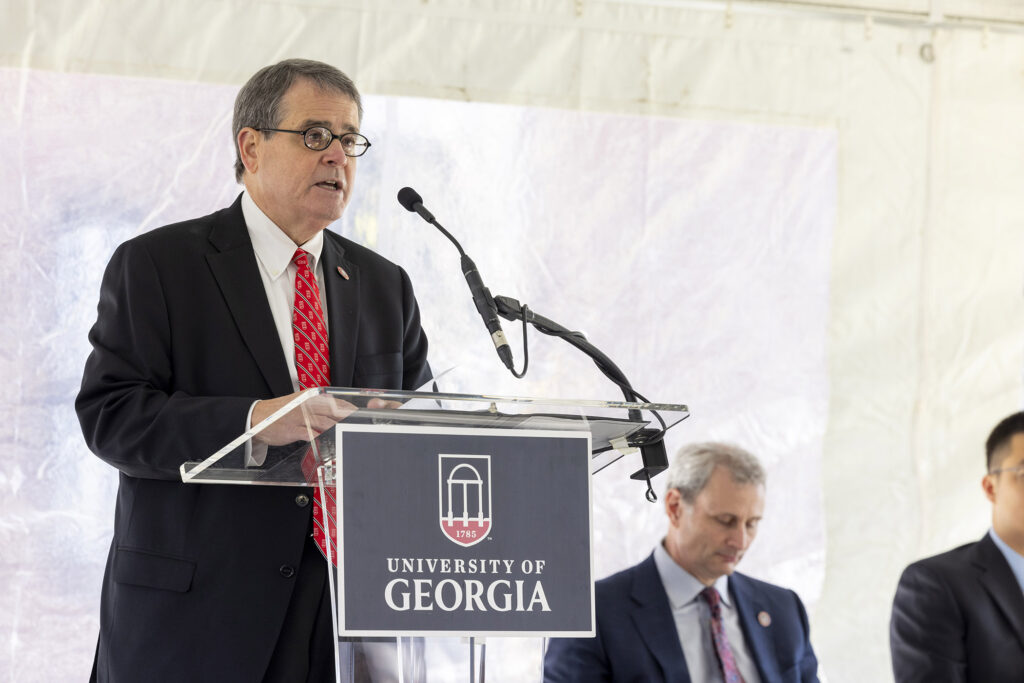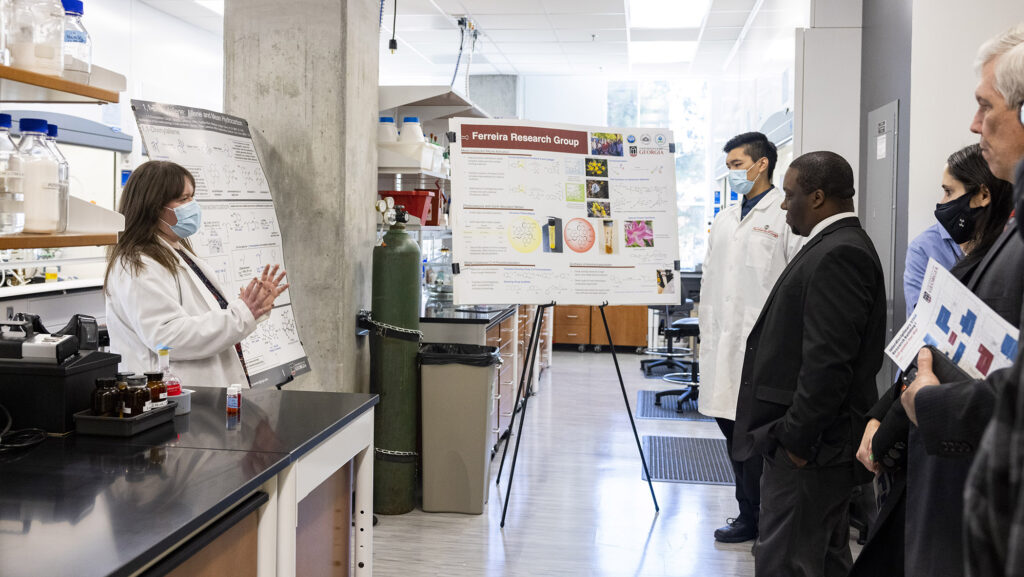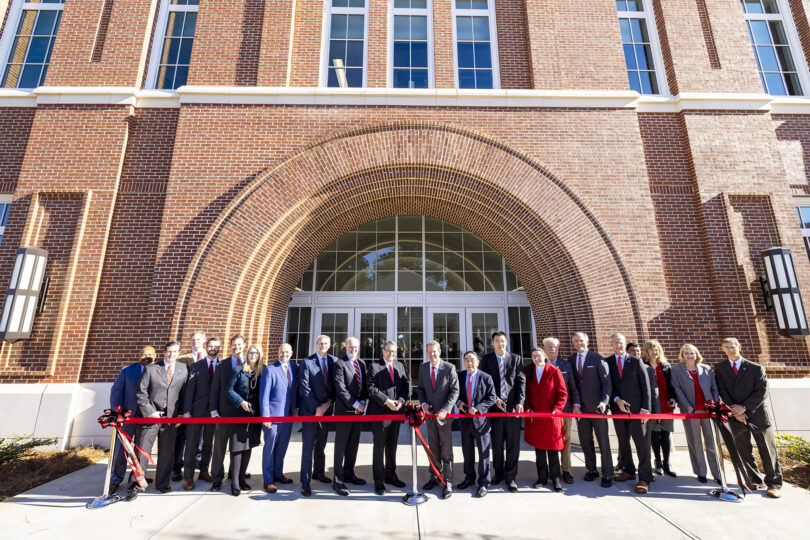The University of Georgia held a ribbon-cutting ceremony to celebrate the completion of the first phase of the Interdisciplinary Science, Technology, Engineering and Math Research Complex on Tuesday, Nov. 30.
The 100,000-square-foot I-STEM Research Building 1 features flexible, open lab spaces designed to promote collaboration and elevate UGA’s expanding lab-intensive research activities, particularly within the disciplines of chemistry, engineering and material sciences. It will soon be united with a phase 2 building, which is currently under construction.
“The opening of the I-STEM Research Building 1 reflects UGA’s commitment to interdisciplinary approaches that are essential to addressing complex, global problems — approaches that will lead to the next generation of products and services that improve our quality of life in Georgia and beyond,” said UGA President Jere W. Morehead.

UGA President Jere W. Morehead speaks during the dedication ceremony. (Photo by Dorothy Kozlowski/UGA)
Georgia Gov. Brian P. Kemp, Franklin College of Arts and Sciences Dean Alan Dorsey, College of Engineering Dean Donald Leo and student speakers Alanna Koritzke and Yang Liu also addressed the crowd of more than 200 people, which included Sen. Frank Ginn, Rep. Houston Gaines, Rep. Marcus Wiedower and members of the University System of Georgia Board of Regents.
The $79.6 million I-STEM Research Building 1, which includes three levels of laboratory and support space and a four-story parking deck underneath, was funded by a combination of university and state funds. It is home to more than 30 faculty and 100 graduate students working in areas ranging from cell imaging and microfluidic separation to combustion chemistry and medical robotics.
“In the I-STEM building alone, our faculty are researching novel ways to detect and treat deadly diseases such as cancer,” said Leo. “And they are researching innovative manufacturing systems for industries that increase the economic competitiveness of our state — industries such as agriculture, the automotive sector, and aerospace.”
The I-STEM buildings are part of a multi-year capital plan to build, renovate and modernize hundreds of thousands of square feet devoted to research and innovation in and around the section of campus known as Science Hill.
In addition to these new buildings, the university is working to modernize existing research facilities on Science Hill to keep pace with continued growth in research and development.
The plan includes renovation of approximately 105,000 square feet in the original Chemistry Building and more than 120,000 square feet of laboratory space in the Biological Sciences Building.
Kemp, who has been an ardent supporter of STEM education, said that, “Georgia has prioritized and invested in a world-class workforce training infrastructure that has quickly become – and remained – the envy of the nation.”
“I am proud to say that our universities and our technical colleges are the engine to that success, supplying companies of all sizes and industries the talent they need to grow their business and create good-paying jobs for hardworking Georgians,” Kemp added. “UGA has been at the forefront of these efforts, from agriculture to business and now STEM. Today’s dedication highlights yet another tool in our toolbelt as a state.”
Located in the heart of UGA’s South Campus science and engineering corridor at the corner of Cedar Street and East Campus Road, the I-STEM research complex will enhance collaboration among chemistry and engineering researchers and their colleagues in the life sciences, agriculture, computer sciences and biomedicine.
“This wonderful new structure — encapsulating the power of that chemistry between science and engineering, between great faculty and students and the tools to propel their best ideas — represents a new era of progress at a critical time in our world,” said Dorsey.
Those attending the ribbon-cutting ceremony were invited to take a self-guided tour of the new research facility, where faculty members and students explained the research projects already underway in the new laboratories.

Organic chemistry student Jessica Budwitz talks about her research to attendees during their building tour. (Photo by Dorothy Kozlowski/UGA)
Koritzke, a doctoral student in chemistry, spoke about the work she and her colleagues are doing in the areas of advanced manufacturing, biosynthetic engineering and nanotechnology.
“These areas of research require state-of-the-art facilities that not only have advanced equipment but that also foster interdisciplinary collaboration, which combine to accelerate our progress,” Koritzke said. “I-STEM demonstrates the University of Georgia’s continued commitment to high-impact scientific research and to creating an enriched network of STEM professionals.”
Liu, who earned his bachelor’s degree in biological engineering at UGA and is now pursuing his doctorate in electrical engineering, told the audience about the importance of collaborative work in the fields of advanced science and engineering, particularly as they relate to his work on microscopy.
“The I-STEM building gives graduate students like me the resources and the space to come together and engage in the kind of collaboration that results in something greater than the sum of its parts,” Liu said. “The open office spaces in the I-STEM building will allow for communication between laboratories and development of innovative projects. My lab members will even have access to a facility where we can quickly prototype and produce customized parts for our microscopes on site.”
Upon the completion of the second phase of the I-STEM research complex, UGA will have added approximately 200,000 square feet of new space for research and instruction. The second phase is scheduled for completion in summer 2022.









